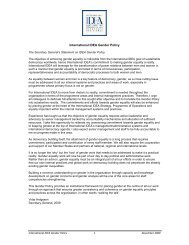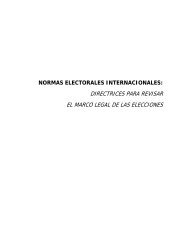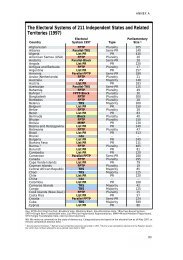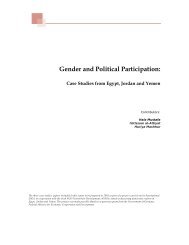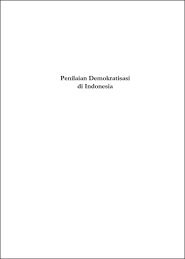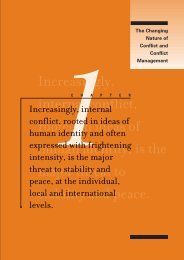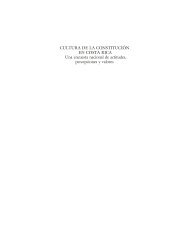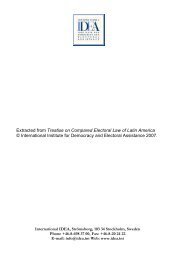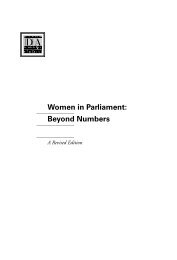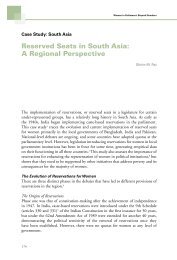The Role of State Constitutions in Protecting ... - International IDEA
The Role of State Constitutions in Protecting ... - International IDEA
The Role of State Constitutions in Protecting ... - International IDEA
Create successful ePaper yourself
Turn your PDF publications into a flip-book with our unique Google optimized e-Paper software.
Overview <strong>of</strong> the Australian federation<br />
Rationale for federation <strong>in</strong> Australia<br />
Australia became a federation largely for reasons <strong>of</strong> history and geography. <strong>The</strong> six<br />
Australian colonies were established by Brita<strong>in</strong> towards the end <strong>of</strong> the 18th<br />
century and <strong>in</strong> the first half <strong>of</strong> the 19th century, around the edge <strong>of</strong> a very large<br />
land mass and on the island <strong>of</strong> Tasmania. <strong>The</strong>y were a long way apart from each<br />
other. By the time a movement for union seriously began, each colony had its own<br />
Constitution and its own <strong>in</strong>stitutions <strong>of</strong> government: Parliament, executive<br />
government and courts. <strong>The</strong> only form <strong>of</strong> union that was politically acceptable <strong>in</strong><br />
these circumstances was federalism. Federalism enabled united action on matters<br />
<strong>of</strong> mutual benefit, while leav<strong>in</strong>g each <strong>of</strong> the colonies, now to become <strong>State</strong>s, with<br />
considerable autonomy to govern themselves.<br />
…federation deepens<br />
democracy, <strong>in</strong> the sense<br />
that it provides two levels<br />
<strong>of</strong> government at which<br />
people can express their<br />
democratic preferences.<br />
…federation operates as a<br />
check and balance; an<br />
important consideration <strong>in</strong> a<br />
system that otherwise relies<br />
heavily on majoritarian<br />
parliamentary government<br />
Even now, more than 100 years later, there is a rationale for federalism <strong>in</strong><br />
Australia. Most obviously, it has the advantage <strong>of</strong> be<strong>in</strong>g the established system <strong>of</strong><br />
government, around which <strong>in</strong>stitutions, expectations and <strong>in</strong>terests have been<br />
built. But it meets other purposes as well. It deepens democracy, <strong>in</strong> the sense that<br />
it provides two levels <strong>of</strong> government at which people can express their democratic<br />
preferences, one <strong>of</strong> which is physically more accessible. Federalism also operates<br />
as a check and balance; an important consideration <strong>in</strong> a system that otherwise<br />
relies heavily on majoritarian parliamentary government, and has resisted<br />
constitutional protection <strong>of</strong> rights.<br />
How Australia became a federation<br />
<strong>The</strong> federation movement began <strong>in</strong> the mid 19th century, but became more<br />
<strong>in</strong>tense <strong>in</strong> the decade <strong>of</strong> the 1890s. <strong>The</strong> pr<strong>in</strong>cipal motivat<strong>in</strong>g factors were the<br />
economic advantages <strong>of</strong> a common tariff policy and a common market and the<br />
need for co-ord<strong>in</strong>ation <strong>in</strong> defense and immigration. <strong>The</strong> process that was followed<br />
to achieve federation <strong>in</strong> the later stages <strong>in</strong>volved a Constitutional Convention<br />
with an equal number <strong>of</strong> delegates from each participat<strong>in</strong>g colony. 10 All but one<br />
<strong>of</strong> the colonies sent delegates directly elected for the purpose by the voters <strong>of</strong> the<br />
colony. In the case <strong>of</strong> South Australia, the voters <strong>in</strong>cluded both men and women,<br />
the latter hav<strong>in</strong>g been enfranchised <strong>in</strong> 1894. No woman delegate was elected,<br />
however. Western Australia sent a delegation appo<strong>in</strong>ted by the Parliament.<br />
<strong>The</strong> Australasian Federal Convention began its task by agree<strong>in</strong>g on a set <strong>of</strong><br />
pr<strong>in</strong>ciples on which the draft Constitution would be based. <strong>The</strong>y were limited, by<br />
modern standards; this nevertheless was an important start<strong>in</strong>g po<strong>in</strong>t for the<br />
Convention's work. In more recent times, the use <strong>of</strong> agreed pr<strong>in</strong>ciples as a basis<br />
for writ<strong>in</strong>g a Constitution has become considerably more sophisticated. <strong>The</strong> 34<br />
constitutional pr<strong>in</strong>ciples on which the South African Constitution was based <strong>of</strong>fer<br />
an excellent example <strong>of</strong> what such pr<strong>in</strong>ciples might look like although, <strong>of</strong> course,<br />
the pr<strong>in</strong>ciples themselves must reflect the consensus that can be reached on what<br />
is appropriate for the community concerned.<br />
10) One colony, Queensland, was not a participant at the Convention but jo<strong>in</strong>ed the movement later.<br />
30




